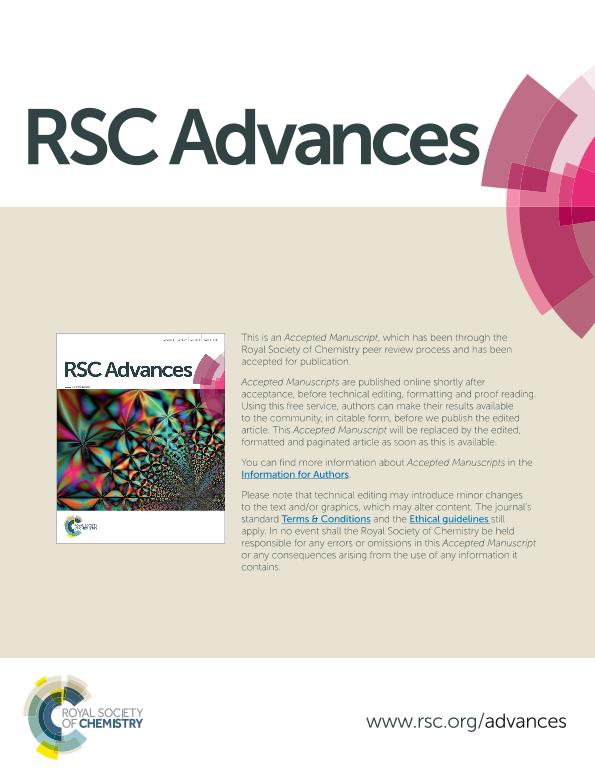Mostrar el registro sencillo del ítem
dc.contributor.author
Douglas Gallardo, Oscar Alejandro

dc.contributor.author
Gomez, C. G.
dc.contributor.author
Macchione, Micaela Alejandra

dc.contributor.author
Cometto, Fernando Pablo

dc.contributor.author
Coronado, Eduardo A.

dc.contributor.author
Perez, Manuel Alejo

dc.date.available
2018-07-03T21:13:41Z
dc.date.issued
2015-11-13
dc.identifier.citation
Douglas Gallardo, Oscar Alejandro; Gomez, C. G.; Macchione, Micaela Alejandra; Cometto, Fernando Pablo; Coronado, Eduardo A.; et al.; Morphological evolution of noble metal nanoparticles in chloroform: Mechanism of switching on/off by protic species; Royal Society of Chemistry; RSC Advances; 5; 122; 13-11-2015; 100488-100497
dc.identifier.uri
http://hdl.handle.net/11336/51127
dc.description.abstract
The morphological stability/morphological reshaping of noble metal nanoparticles are studied experimentally in order to unravel the chemical mechanisms lying beneath. Gold and silver nanoparticles (AuNPs and AgNPs, respectively) formed in a chloroformic environment are used, as model synthetic systems, to study the phenomena of morphological change. The morphological evolution of NPs that follows their formation, is characterized by spectroscopy (UV-visible, Raman and FTIR) and TEM (Transmission Electron Microscopy). The change of NP morphology involves the increase of the average NP size and the broadening of size distribution, in a close resemblance with the effect characteristically obtained from the Ostwald ripening. The effect of the poor solvating properties of chloroform in stabilizing small charged species (H+, Ag+, Au+) as well as the principle of electroneutrality of matter are analyzed in order to formulate a feasible reaction scheme consisting of a three-step process: the generation of soluble intermediary species by corrosion of nanoparticles, the diffusion of intermediary species from one nanoparticle to another, and the re-deposition process involving the reduction of intermediary species. This basic reaction scheme is used as a hypothesis to plan and perform experiments, which reveal that molecular oxygen dissolved in the dispersive medium can drive NP corrosion, however, protic species are also required as co-reactants. The polarity of the hydrogen bond and the ligand properties of the anions produced by de-protonation are features of the protic species that enable/disable corrosion and, in turn, the NP morphological evolution.
dc.format
application/pdf
dc.language.iso
eng
dc.publisher
Royal Society of Chemistry

dc.rights
info:eu-repo/semantics/openAccess
dc.rights.uri
https://creativecommons.org/licenses/by-nc-sa/2.5/ar/
dc.subject
Nanoparticles
dc.subject
Ostwald Ripening
dc.subject
Mechanisms
dc.subject.classification
Otras Ciencias Químicas

dc.subject.classification
Ciencias Químicas

dc.subject.classification
CIENCIAS NATURALES Y EXACTAS

dc.title
Morphological evolution of noble metal nanoparticles in chloroform: Mechanism of switching on/off by protic species
dc.type
info:eu-repo/semantics/article
dc.type
info:ar-repo/semantics/artículo
dc.type
info:eu-repo/semantics/publishedVersion
dc.date.updated
2018-05-04T21:42:00Z
dc.identifier.eissn
2046-2069
dc.journal.volume
5
dc.journal.number
122
dc.journal.pagination
100488-100497
dc.journal.pais
Reino Unido

dc.journal.ciudad
Cambridge
dc.description.fil
Fil: Douglas Gallardo, Oscar Alejandro. Consejo Nacional de Investigaciones Científicas y Técnicas. Centro Científico Tecnológico Conicet - Córdoba. Instituto de Investigaciones en Físico-química de Córdoba. Universidad Nacional de Córdoba. Facultad de Ciencias Químicas. Instituto de Investigaciones en Físico-química de Córdoba; Argentina
dc.description.fil
Fil: Gomez, C. G.. Universidad Nacional de Córdoba. Facultad de Ciencias Químicas. Departamento de Química Orgánica; Argentina
dc.description.fil
Fil: Macchione, Micaela Alejandra. Consejo Nacional de Investigaciones Científicas y Técnicas. Centro Científico Tecnológico Conicet - Córdoba. Instituto de Investigaciones en Físico-química de Córdoba. Universidad Nacional de Córdoba. Facultad de Ciencias Químicas. Instituto de Investigaciones en Físico-química de Córdoba; Argentina
dc.description.fil
Fil: Cometto, Fernando Pablo. Consejo Nacional de Investigaciones Científicas y Técnicas. Centro Científico Tecnológico Conicet - Córdoba. Instituto de Investigaciones en Físico-química de Córdoba. Universidad Nacional de Córdoba. Facultad de Ciencias Químicas. Instituto de Investigaciones en Físico-química de Córdoba; Argentina
dc.description.fil
Fil: Coronado, Eduardo A.. Consejo Nacional de Investigaciones Científicas y Técnicas. Centro Científico Tecnológico Conicet - Córdoba. Instituto de Investigaciones en Físico-química de Córdoba. Universidad Nacional de Córdoba. Facultad de Ciencias Químicas. Instituto de Investigaciones en Físico-química de Córdoba; Argentina
dc.description.fil
Fil: Perez, Manuel Alejo. Consejo Nacional de Investigaciones Científicas y Técnicas. Centro Científico Tecnológico Conicet - Córdoba. Instituto de Investigaciones en Físico-química de Córdoba. Universidad Nacional de Córdoba. Facultad de Ciencias Químicas. Instituto de Investigaciones en Físico-química de Córdoba; Argentina
dc.journal.title
RSC Advances
dc.relation.alternativeid
info:eu-repo/semantics/altIdentifier/url/http://pubs.rsc.org/en/content/articlelanding/2015/ra/c5ra17529a#!divAbstract
dc.relation.alternativeid
info:eu-repo/semantics/altIdentifier/doi/http://dx.doi.org/10.1039/c5ra17529a
dc.relation.alternativeid
info:eu-repo/semantics/altIdentifier/url/https://www.ncbi.nlm.nih.gov/pmc/articles/PMC4754205/
Archivos asociados
